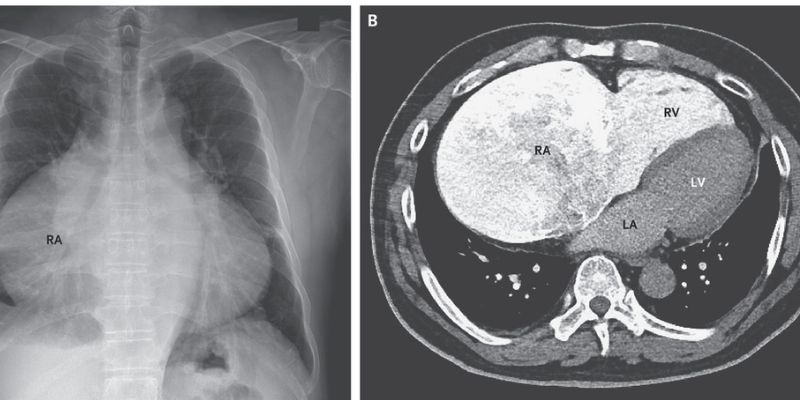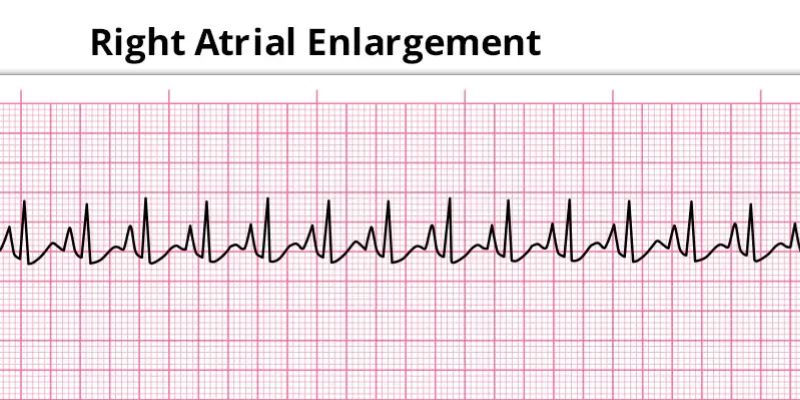Right atrial enlargement, also known as cor pulmonale right ventricular, is a condition many people don't know much about. This type of heart disease is caused by increased pressure due to challenges in the pulmonary artery, which carries blood from the lungs to the right side of the heart.
Although uncommon, this condition can seriously affect your health if left untreated. In this blog post, we will explore what exactly right atrial enlargement is and what causes it so that you can better understand how to avoid or manage it effectively.
What Is Right Atrial Enlargement

Right atrial enlargement, also known as right atrial dilation or right atrial hypertrophy, refers to an increase in the size or volume of the right atrium, one of the heart's four chambers. It is typically caused by underlying medical conditions that affect the heart and lungs.
Deoxygenated blood from the body is taken up by the coronary atrium and pumped into the ventricle on the right, which then pumps the blood to the lungs for oxygenation. The right atrium can expand, which can cause a number of symptoms and difficulties as well as interfere with the heart's regular operation.
Types of Right Atrial Enlargement
Right atrial enlargement can be categorized into two main types based on the pattern of enlargement observed on electrocardiography (ECG). These types are:
Right Atrial Enlargement (RAE)
In this type, there is a generalized enlargement of the right atrium, resulting in an overall increase in size. RAE is often associated with conditions that cause increased pressure in the pulmonary circulation, such as pulmonary hypertension or chronic lung diseases.
Right Atrial Dilatatio
It refers to a more localized enlargement or dilation of a specific part of the right atrium, usually the appendage or the superior vena cava (SVC) portion. It can be seen in conditions that cause chronic volume overload or pressure overload in these regions.
Symptoms of Right Atrial Enlargement

The symptoms of right atrial enlargement can vary depending on the underlying cause and extent. Some common symptoms associated with right atrial enlargement include:
- Fatigue: Increased workload on the heart due to an enlarged right atrium can lead to reduced cardiac output, resulting in fatigue and a decreased ability to engage in physical activities.
- Shortness of breath: Enlargement of the right atrium can impair the heart's ability to pump blood efficiently, causing fluid to back up into the lungs. This can result in shortness of breath, especially during exertion or when lying flat.
- Swelling: Right atrial enlargement can cause fluid retention, leading to swelling in the legs, ankles, feet, and sometimes the abdomen. This swelling is known as edema and is often more noticeable at the end of the day or after prolonged periods of standing or sitting.
- Palpitations: Some individuals with right atrial enlargement may experience a sensation of rapid, fluttering, or pounding heartbeats. This can be due to heart electrical system disturbances or arrhythmias.
- Increased susceptibility to arrhythmias: Right atrial enlargement can disrupt the heart's normal electrical conduction, making individuals more prone to developing abnormal heart rhythms, such as atrial fibrillation or atrial flutter.
- Fainting or dizziness: In severe cases, right atrial enlargement can compromise blood flow to the brain, leading to episodes of fainting or dizziness.
- Chest discomfort: Enlargement of the right atrium may cause a sense of fullness or pressure in the chest. This symptom is less common but can occur in some individuals.
When Is Discomfort an Emergency
- Chest pain that persists even after rest or taking medication.
- Shortness of breath that occurs even at rest.
- Dizziness, particularly if it is sudden and severe.
- Coughing up pink phlegm or blood.
- Loss of consciousness, fainting, or passing out.
- Unresponsiveness or inability to be awakened or interact with others.
Causes of Right Atrial Enlargement
Causes of Right Atrial Enlargement include:
- Atrial fibrillation
- Congestive heart failure
- Chronic obstructive pulmonary disease (COPD)
- Pulmonary hypertension
- Pulmonary stenosis
- Tetralogy of Fallot
- Tricuspid stenosis or regurgitation
- Pulmonary atresia
- Septal defects
- Heart valve disorders.
Who Does Right Atrial Enlargement Affect
Right atrial enlargement can affect individuals who have the following conditions:
- Congenital heart diseases affecting the right side include conditions like tetralogy of Fallot and pulmonary stenosis, which can lead to right atrial enlargement.
- Heart valve diseases impacting the right side: Conditions such as tricuspid stenosis, where the tricuspid valve has a narrow opening, can cause right atrial enlargement.
- Cor pulmonale and right heart failure: Weakness of the right ventricle due to lung problems, such as chronic lung diseases or pulmonary hypertension, can lead to right atrial enlargement.
- Supraventricular tachycardia refers to an abnormally fast heart rate originating above the ventricles, which can contribute to right atrial enlargement.
- Right ventricular hypertrophy: Enlargement of the right lower chamber of the heart can lead to increased strain on the right atrium, resulting in its enlargement.
- Atrial fibrillation: A rapid and disorganized heartbeat can disrupt normal atrial function and contribute to right atrial enlargement.
- Atrial flutter: Abnormally fast atria contractions can lead to right atrial enlargement.
- Chronic obstructive pulmonary disease (COPD): This group of lung diseases, including chronic bronchitis and emphysema, can strain the heart and contribute to right atrial enlargement.
- Pulmonary hypertension: Increased pressure in the pulmonary artery can cause the right atrium to enlarge as it works harder to pump blood against the elevated resistance.
Diagnosis
- Electrocardiogram (ECG/EKG): Your healthcare provider will perform an ECG by attaching electrodes to your chest, limbs, and, sometimes, the neck. The ECG measures the electrical activity of the heart. In right atrial enlargement, the "P wave" representing the right atrium's contraction appears larger than normal on the ECG, typically exceeding 1 mm in height.
- Fetal echocardiogram: This diagnostic test assesses a developing baby's heart before birth. It can help detect any abnormalities or enlargement in the right atrium.
- Transthoracic echocardiogram (TTE): TTE is a common imaging technique that uses sound waves to create real-time images of the heart. It provides detailed information about the size, shape, and function of the right atrium, allowing for the detection of enlargement.
- Cardiac computed tomography (CT) scan: CT scans use X-ray technology to create cross-sectional heart images. It can provide detailed anatomical information about the heart chambers, including the right atrium, and help identify any enlargement.
- Heart MRI (magnetic resonance imaging): MRI uses a magnetic field and radio waves to generate detailed heart images. It can provide information about the structure, function, and blood flow within the heart, aiding in diagnosing right atrial enlargement.
Treatment
Treatment of right atrial enlargement depends on the underlying cause and the severity of the condition. Surgical options, such as resection or ablation, may be considered in severe cases. Conservative treatment options include:
- Regular monitoring.
- Medication (beta-blockers and anticoagulants).
- Implanted devices (pacemakers or defibrillators).
- Medications to control blood pressure or heart rate.
A healthcare professional should determine The specific treatment approach based on individual circumstances.
Complications
Complications of right atrial enlargement include supraventricular tachycardia, atrial fibrillation, atrial flutter, right-sided heart failure, pulmonary embolism, heart attack, and sudden cardiac death. The condition can progress unnoticed without symptoms, leading to more severe problems.
FAQs
Is right atrial enlargement reversible?
In some cases, yes. If the underlying cause is treated and managed properly, right atrial enlargement may be reversible in certain individuals.
How can right atrial enlargement be prevented?
The best way to prevent right atrial enlargement is to address any underlying conditions that can contribute to the condition, including high blood pressure, congestive heart failure, COPD, and pulmonary hypertension.
Is right atrial enlargement serious?
Yes, right atrial enlargement can be serious if left untreated. It can lead to serious complications such as heart attack or sudden cardiac death.
Conclusion
Right atrial enlargement (RAE) is a heart condition with increased right atrium size. It has several types. Symptoms vary depending on the type, ranging from fatigue to chest pain or discomfort. Various factors can cause it and can affect any age group. A medical professional must diagnose the condition through imaging techniques. Treatment options such as medication, ablation, and surgery are used to treat the enlarged right atrium and any existing complications connected to its presence.




